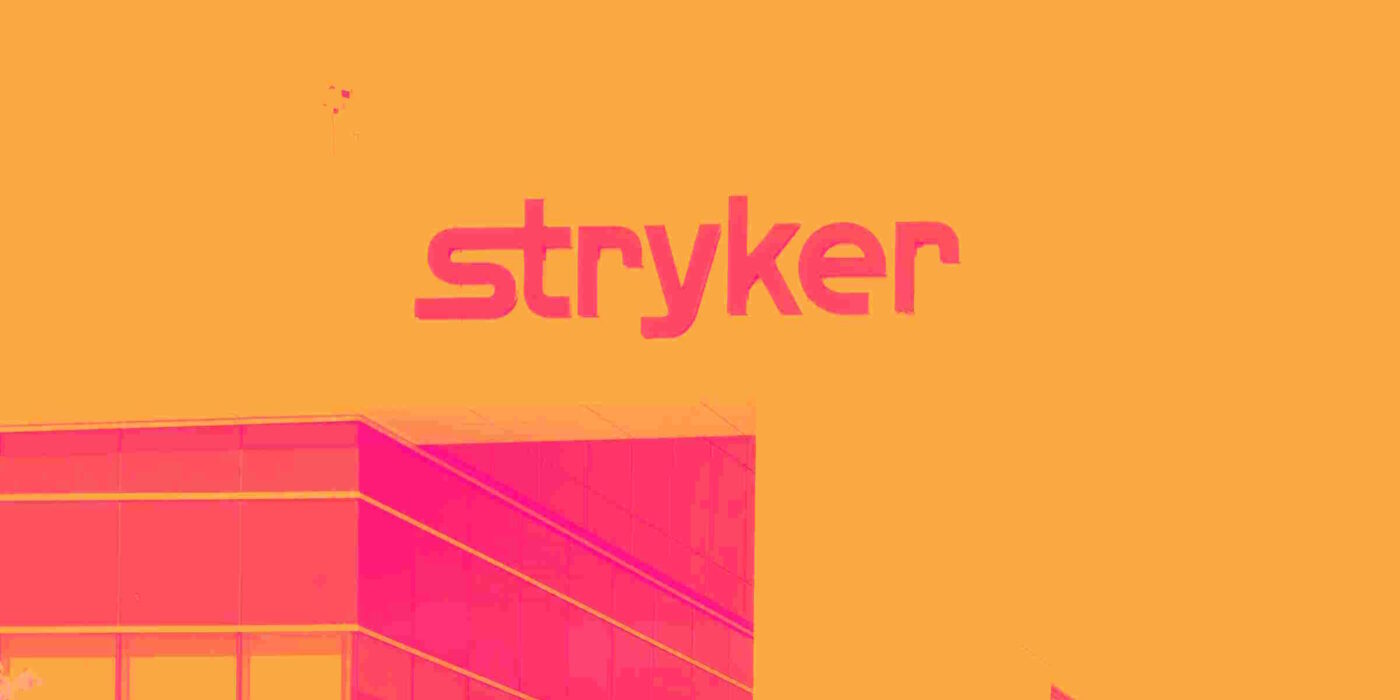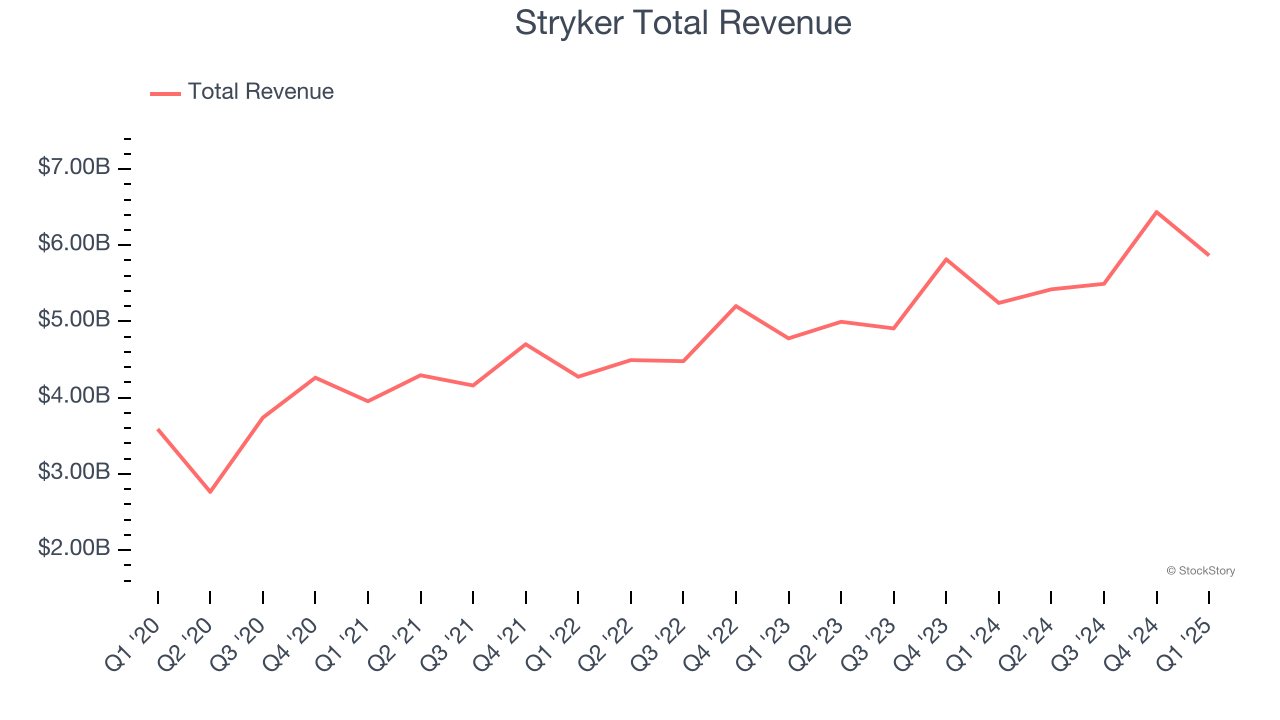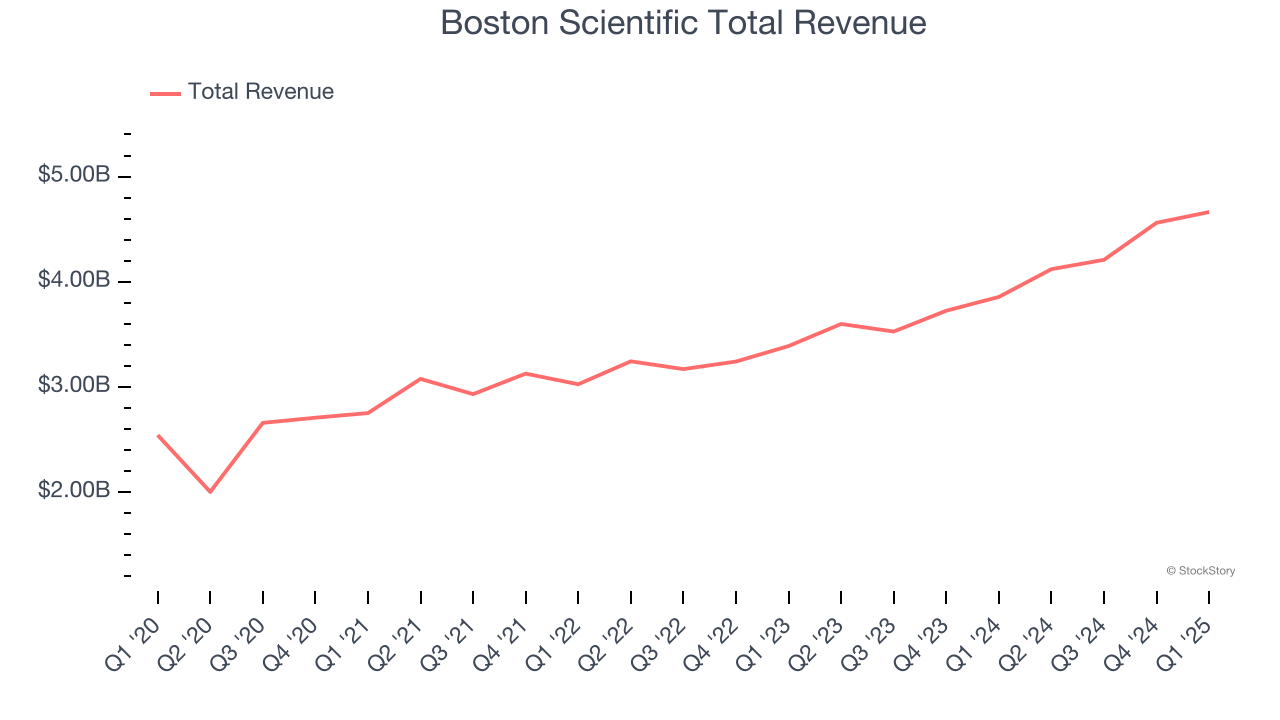
Wrapping up Q1 earnings, we look at the numbers and key takeaways for the medical devices & supplies - diversified stocks, including Stryker (NYSE: SYK) and its peers.
The medical devices industry operates a business model that balances steady demand with significant investments in innovation and regulatory compliance. The industry benefits from recurring revenue streams tied to consumables, maintenance services, and incremental upgrades to the latest technologies. However, the capital-intensive nature of product development, coupled with lengthy regulatory pathways and the need for clinical validation, can weigh on profitability and timelines. In addition, there are constant pricing pressures from healthcare systems and insurers maximizing cost efficiency. Over the next several years, one tailwind is demographic–aging populations means rising chronic disease rates that drive greater demand for medical interventions and monitoring solutions. Advances in digital health, such as remote patient monitoring and smart devices, are also expected to unlock new demand by shortening upgrade cycles. On the other hand, the industry faces headwinds from pricing and reimbursement pressures as healthcare providers increasingly adopt value-based care models. Additionally, the integration of cybersecurity for connected devices adds further risk and complexity for device manufacturers.
The 5 medical devices & supplies - diversified stocks we track reported a mixed Q1. As a group, revenues beat analysts’ consensus estimates by 1.1% while next quarter’s revenue guidance was in line.
In light of this news, share prices of the companies have held steady. On average, they are relatively unchanged since the latest earnings results.
Stryker (NYSE: SYK)
With over 150 million patients impacted annually through its innovative healthcare technologies, Stryker (NYSE: SYK) develops and manufactures advanced medical devices and equipment across orthopedics, surgical tools, neurotechnology, and patient care solutions.
Stryker reported revenues of $5.87 billion, up 11.9% year on year. This print exceeded analysts’ expectations by 3.2%. Overall, it was a strong quarter for the company with a solid beat of analysts’ organic revenue estimates and a decent beat of analysts’ EPS estimates.
“Our 2024 momentum continued into the first quarter as we delivered double-digit organic sales growth and continued to expand adjusted operating margins,” said Kevin A. Lobo, Chair and CEO.

Stryker achieved the biggest analyst estimates beat of the whole group. Unsurprisingly, the stock is up 2% since reporting and currently trades at $381.36.
Is now the time to buy Stryker? Access our full analysis of the earnings results here, it’s free.
Best Q1: Boston Scientific (NYSE: BSX)
Founded in 1979 with a mission to advance less-invasive medicine, Boston Scientific (NYSE: BSX) develops and manufactures medical devices used in minimally invasive procedures across cardiovascular, urological, neurological, and gastrointestinal specialties.
Boston Scientific reported revenues of $4.66 billion, up 20.9% year on year, outperforming analysts’ expectations by 2%. The business had a very strong quarter with a solid beat of analysts’ organic revenue and EPS estimates.

Boston Scientific pulled off the fastest revenue growth among its peers. The market seems happy with the results as the stock is up 9.6% since reporting. It currently trades at $104.05.
Is now the time to buy Boston Scientific? Access our full analysis of the earnings results here, it’s free.
Weakest Q1: Neogen (NASDAQ: NEOG)
Founded in 1981 and operating at the intersection of food safety and animal health, Neogen (NASDAQ: NEOG) develops and manufactures diagnostic tests and related products to detect dangerous substances in food and pharmaceuticals for animal health.
Neogen reported revenues of $221 million, down 3.4% year on year, falling short of analysts’ expectations by 1.5%. It was a disappointing quarter as it posted a significant miss of analysts’ EPS estimates and full-year EBITDA guidance missing analysts’ expectations.
Neogen delivered the weakest performance against analyst estimates and slowest revenue growth in the group. As expected, the stock is down 19.5% since the results and currently trades at $5.65.
Read our full analysis of Neogen’s results here.
Abbott Laboratories (NYSE: ABT)
With roots dating back to 1888 when founder Dr. Wallace Abbott began producing precise, dosage-form medications, Abbott Laboratories (NYSE: ABT) develops and sells a diverse range of healthcare products including medical devices, diagnostics, nutrition products, and branded generic pharmaceuticals.
Abbott Laboratories reported revenues of $10.36 billion, up 4% year on year. This result was in line with analysts’ expectations. Taking a step back, it was a mixed quarter as it also logged a decent beat of analysts’ EPS estimates but a slight miss of analysts’ organic revenue estimates.
The stock is up 4.9% since reporting and currently trades at $132.40.
Read our full, actionable report on Abbott Laboratories here, it’s free.
Baxter (NYSE: BAX)
With a history dating back to 1931 and products used in over 100 countries, Baxter International (NYSE: BAX) provides essential healthcare products including dialysis therapies, IV solutions, infusion systems, surgical products, and patient monitoring technologies to hospitals and clinics worldwide.
Baxter reported revenues of $2.63 billion, up 5.4% year on year. This print topped analysts’ expectations by 1.9%. Overall, it was a strong quarter as it also logged a solid beat of analysts’ constant currency revenue estimates and an impressive beat of analysts’ EPS estimates.
The stock is flat since reporting and currently trades at $30.87.
Read our full, actionable report on Baxter here, it’s free.
Market Update
Thanks to the Fed’s rate hikes in 2022 and 2023, inflation has been on a steady path downward, easing back toward that 2% sweet spot. Fortunately (miraculously to some), all this tightening didn’t send the economy tumbling into a recession, so here we are, cautiously celebrating a soft landing. The cherry on top? Recent rate cuts (half a point in September 2024, a quarter in November) have propped up markets, especially after Trump’s November win lit a fire under major indices and sent them to all-time highs. However, there’s still plenty to ponder — tariffs, corporate tax cuts, and what 2025 might hold for the economy.
Want to invest in winners with rock-solid fundamentals? Check out our Top 6 Stocks and add them to your watchlist. These companies are poised for growth regardless of the political or macroeconomic climate.
Join Paid Stock Investor Research
Help us make StockStory more helpful to investors like yourself. Join our paid user research session and receive a $50 Amazon gift card for your opinions. Sign up here.







